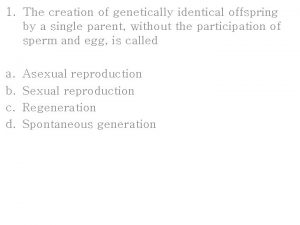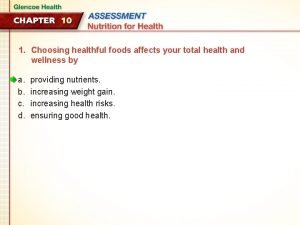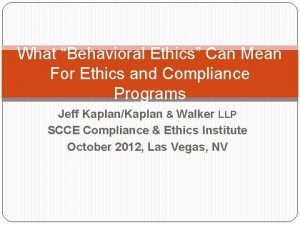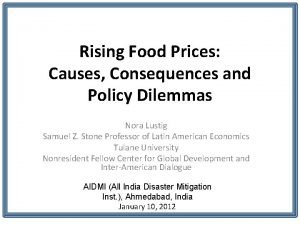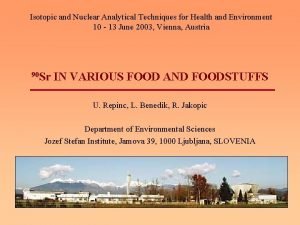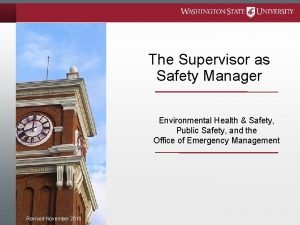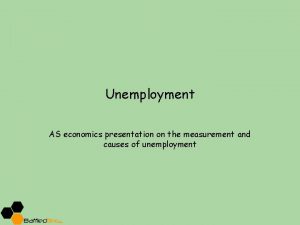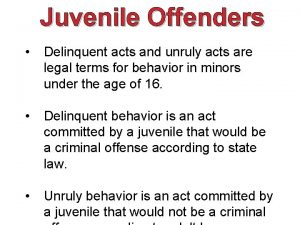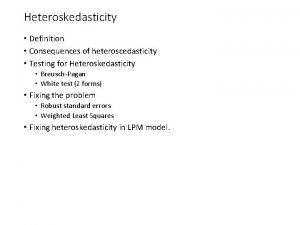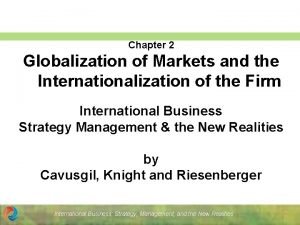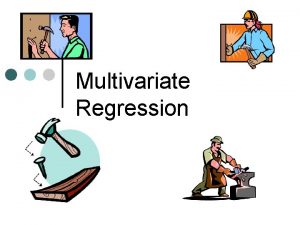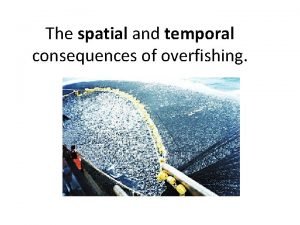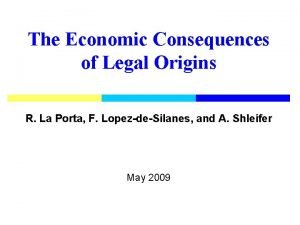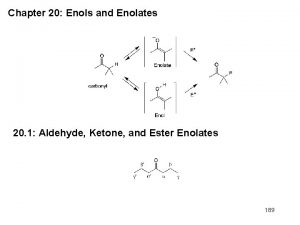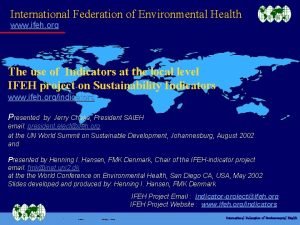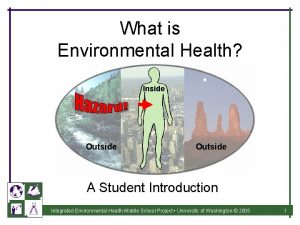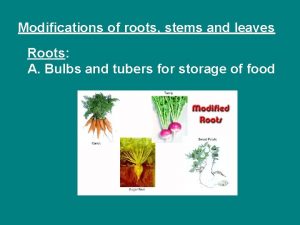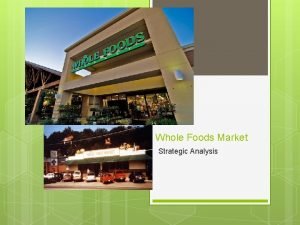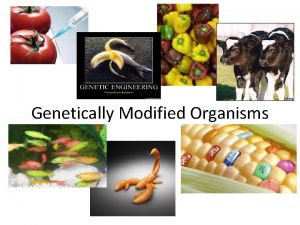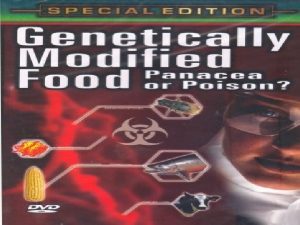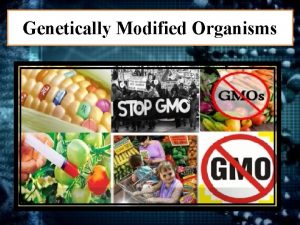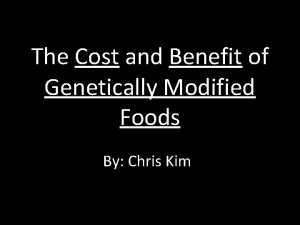Health and Environmental Consequences of Genetically Modified Foods





























































































































- Slides: 125

Health and Environmental Consequences of Genetically. Modified Foods Martin Donohoe

Outline n GMOs n Corporate agribusiness n Health and Environmental Risks n Labeling n Solutions n Resources

Food Justice Issues n Hunger and malnutrition n Over 3 million child deaths/yr worldwide n One Hiroshima every 8 days n Hunger and food insecurity affect 20 -25% of Americans n Obesity

Food Justice Issues n Water shortages n Soil erosion exceeds soil formation n Overuse of agricultural antibiotics/antibiotic- resistant food-borne illnesses

Food Justice Issues n Underfunded/understaffed food inspection system n Indoor cooking fires n Corporate influence n Impediments to science

The Precautionary Principle When evidence points toward the potential of an activity to cause significant, widespread or irreparable harm to public health or the environment, options for avoiding that harm should be examined and pursued, even though the harm is not yet fully understood or proven.

The Precautionary Principle n Give human and environmental health the benefit of doubt. n Include appropriate public participation in the discussion. n Gather unbiased scientific, technological and socioeconomic information. n Consider less risky alternatives.

Genetically-Modified Organisms n Plants/animals whose DNA has been altered through the addition of genes from other organisms n Development - 1982 n First commercially available crops - 1994

Genetically-Modified Crops n GM Crops grown commercially by 18 million of the world’s 513 million small farmers on over 457 million acres spread over 26 countries (2016) n 4% of all global agricultural land 13% of global arable land planted with GM crops n 175 million acres in U. S. (1/2 total land used for crops) n Most used for animal feed and biofuel production, as well as fiber production




Genetic Modification of Conventional Crops (US) n 95% of sugar beets n 94% of soybeans n 93% of canola n 90% of cotton n 88% of corn

Purported Purposes of Genetically. Modified Crops n Enhance nutritional quality n Drought resistance n Increase growth rate n Enhance ripening n Prevent spoilage n Change appearance n Alter freezing properties

Actual Characteristics of Genetically. Modified Crops n 70 -93% herbicide-resistant n 94% soybeans n 78% cotton n 18% produce their own pesticide n E. g. , Bt corn, modified to produce insecticidal proteins such as Cry 1 Ab (active against corn borer) n 8% produce their own pesticide and are herbicideresistant

Genetically-Modified Foods n 85% of processed foods available in the U. S. today come from GM crops n Global value of GE seeds sold annually = $15 billion

Agricultural/Biotech Companies Mid-1970 s: none of the 7, 000 seed companies controlled over 0. 5% of world seed market n Today: less than 10 corporations control ¾ of global proprietary seed sales n Bayer (including Monsanto post merger), Du. Pont/Dow, and Chem China (bought Syngenta) control 60% n 94% of seed varieties have disappeared over the last century n

Agricultural/Biotech Companies n Biotech companies conduct/sponsor much research n Dangers include secrecy, suppression of data n Large 2017 review of over 600 published studies on GM Bt crops showed 40% had conflicts of interest n Presence of COI associated with 50% higher frequency of outcomes favorable to the GM crop company n Open-science movement would counteract

Agricultural/Biotech Companies n Many major agricultural biotech companies also pharmaceutical companies (*): n n n n Novartis Seeds* Aventis Crop. Science* Bayer Crop. Science* (purchases Monsanto, 2018 – Monsanto name dropped) BASF* (bought multiple seed and herbicide businesses from Bayer in 2017) Dupont/Pioneer (merged with Dow, 2015) Dow* (merged with Dupont, 2015) Syngenta* (acquired by Chem. China, 2016) Public tribunal investigating most for human rights violations

GMO Crop Producers’ Other Activities n Chemical weapons: n Monsanto (Agent Orange, PCBs, dioxins), Dow (napalm), Hoechst (mustard gas) n Pesticides: n Monsanto (DDT), Dow (dioxins, PCBs, Dursban)

GMO Crop Producers’ Other Activities n Ozone-destroying chlorofluorocarbons: n Dupont and Hoechst (merged with Rhone Poulenc to form Aventis) major producers n Agricultural Antibiotics: n Many companies – overuse of agricultural antibiotics on factory farms is the #1 cause of antibiotic-resistant food-borne infections in humans

GMO Crop Producers’ Other Activities n Pharmaceutical Industry n Price gouging n Seeding trials n Unethical studies (often in developing world) n Selective publication/data hoarding n Threats against legitimate scientists n Misleading advertising

GMO Crop Producers’ Other Activities n Lobbying n Campaign donations n Companies sponsor professorships, academic research institutes n Support secondary school “science education” through sponsored curricula

Monsanto n 90% of GM seeds sold by Monsanto or by competitors that license Monsanto genes in their own seeds n $8. 2 billion profit on $15 billion revenues in 2015

Monsanto n Extensive record of: n Pollution n Criminal Activity n Financial malfeasance n Bribery n Suing farmers whose fields are contaminated with GMOs n Human rights violations n Ethical improprieties

Monsanto n Campaign contributions (2016 election cycle): over $600, 000 through early 10 -16 n U. S. Lobbying expenditures (2016): $4. 6 million n Forbes magazine’s Company of the Year (2009) n #1 on Corporate Accountability’s Corporate Hall of Shame list (2010) n Consistently in top ten lists of world’s worst corporations

“Golden Rice”: The Poster Child of GE n Purported to be the solution to the problem of Vitamin A Deficiency (VAD) in developing countries n Severe VAD causes blindness (350, 000 children/year) n Lesser deficiencies weaken the immune system, increasing risk of infectious diseases and death (>1 million deaths/yr)

Golden Rice n Produces β-carotene, which the body converts into Vitamin A (in the absence of other nutritional deficiencies - such as zinc, protein, and fats - and in individuals not suffering from diarrhea)

“Not-So Golden” Rice n Crop not yet adapted to local climates in developing countries n Amounts produced minute in early versions n Β-carotene is a pro-oxidant, which may be carcinogenic n 2018: FDA approves sale of version while acknowledging no nutritional benefits

“Not-So Golden” Rice n Unethical feeding trials conducted in Chinese children by Tufts University investigators (backed by USDA) n Done without preceding animal studies n Parents not informed re use of GM rice n. Violates Nuremberg Code n. Published in Am J Clin Nutr (2011); Criticized in Nature (2012); Am J Clin Nutr to retract

Curing Vitamin A Deficiency n VAD can be cured: n With breast milk and small to moderate amounts of vegetables, whose cultivation has decreased in the face of monoculture and export crops n By providing vitamin A and zinc supplements to malnourished infants and toddlers under age 2 n Cost = $60 million/yr n Benefits (including prevention of blindness and malnutrition) > $1 billion/yr n With political and social will

OR 2002 Ballot Measure 27 n Defeated 70% to 30% n Opponents outspent proponents $5. 5 million to $200, 000 n Vast majority of opposition funding from corporations headquartered outside state: n Surprising, since multiple polls conducted by the news media, government and industry show from 85 -95% of US citizens favor labeling

Opposition Tactics Corporations/Corporate front groups n Fears of higher food costs n Accused Measure’s supporters of being “against national policy and scientific consensus”, “technophobic, ” and “anti -progress” n Argued that labels would provide “unreliable, useless information that would unnecessarily confuse, mislead and alarm consumers” n

Opposition Tactics n Claimed USDA, EPA and FDA evaluate safety of GE products from inception to “final approval” n USDA deals with field testing, EPA with environmental concerns, FDA considers GE foods equivalent to non-GE foods n EPA requires only short-term animal testing (3090 days, which is how long most industry studies last)

Opposition Tactics n Claimed USDA, EPA and FDA evaluate safety of GE products from inception to “final approval” n Industry selects which data to submit n FDA policy on GE foods overseen by former Monsanto attorney Michael Taylor, who became a Monsanto VP after leaving FDA n. No requirement for human safety testing


Conflicts of Interest n Supreme Court Justice Clarence Thomas: former General Counsel for Monsanto (Bush I appointee) n Current labeling opponents

Failure of Regulatory Oversight n n Nearly 1/5 FDA scientists “have been asked, for non-scientific reasons, to inappropriately exclude or alter technical information or their conclusions in an FDA scientific document” n Similar to global warming report from NASA, Plan B EC data, Medicare Part D data, etc. n A new “Dark Ages” for US science FDA under-funded and under-staffed n Only ¼ of FDA’s resources allocated to food program, down from ½ in 1972

Failure of Regulatory Oversight n “The Department of Agriculture has failed to regulate field trials of GE crops adequately” n USDA Office of Inspector General (2006) n 2016: OIG (DHHS) finds FDA’s procedures to recall contaminated or misbranded foor are inadequate

Food Labeling in the U. S. n Vitamin, mineral, caloric and fat content n Sulfites (allergies) n Source of proteins (vegetarians [6% of U. S. population], vegans [3%]) n Kosher/Hallal n Not from concentrate

Food Labeling in the U. S. n Recycled contents n Wild n Union made n Made in USA n COOL (Country of Origin Labeling) – took effect in mid 2000 s in U. S. , overturned by Congress in 2015 after WTO ruled against U. S.

GE Food Labeling Worldwide n 64 countries n Many European countries have banned GMO crops

Labeling n Scott Faber, former VP for Federal Affairs at Grocery Manufacturers Assn. n “What I learned is that adding a few words to a label has no impact on the price of making or selling food” n Monsanto-sponsored “Underground Adventure” exhibit at Chicago’s Field Museum


Monsanto Has Supported Labeling When the EU adopted labeling in the late 1990 s, Monsanto ran ads in the UK that read: n “Monsanto fully supports UK food manufacturers and retailers in their introduction of these labels. We believe you should be aware of all the facts before making a purchase. ” n Monsanto UK employee cafeteria is GMO-free n Monsanto CEO buys organic n

Labeling n Labeling did not increase costs of food in any of the other countries with labeling laws n Consumers Union – no increased costs expected with Oregon Measure 92 n ECONorthwest study - $2. 30/person/year n Labels are changed frequently – think “New and Improved”

Benefits of Labeling GE Foods Prevent allergic reactions n Soybeans modified with Brazil nut genes (noted premarketing, never commercialized) n Allow vegetarians to avoid animal genes n Tomatoes with flounder genes n Heighten public awareness of genetic engineering n Only 1/4 Americans believe they have eaten GM foods n

Benefits of Labeling GE Foods n Grant people freedom to choose what they eat based on individual willingness to confront risk n Ensure healthy public debate over the merits of genetic modification of foodstuffs

Health Risks of GE Foods Animal and Human Studies n Adverse effects on multiple organs n Tumors n Changes in immune cells and increases in inflammatory mediators n Impaired fertility, increased miscarriages n Increased allergies n Premature death

GE Crops and Herbicide/Insecticide Use n Overall herbicide use up over 15 -fold between 1996 and 2014 n 19 billion lbs of glyphosate sprayed between 1996 and 2016 n 20 -fold increase in glyphosate spraying in US between 1995 and 2014 (to 250 million lbs/yr) n ¾ lb/acre sprayed on cropland in US, ½ lb/acre worldwide (2014)

GE Crops and Herbicide/Insecticide Use n Overall insecticide use down 123 million pounds between 1996 and 2011 n But pests now becoming resistant, so insecticide use starting to increase n Use up 1/3 in cotton n Meta-analysis of Bt corn and cotton (2013): n 5/13 major pests resistant (compared with 1 in 2005)

Health and Environmental Risks of GE Foods n Greater herbicide use n Confirmed by multiple studies n U. S. 1. 6 billion kg (19 % of global use[8. 6 billion kg]) applied 1974 -2014 n 15 -fold increased use since “Roundup Ready” crops introduced in 1996

Health and Environmental Risks of GE Foods n Greater herbicide use n 2/3 of total U. S. glyphosate use in U. S. from 1974 -2014 sprayed between 2004 and 2014 (globally 72 %) n ¾ lb/acre sprayed on cropland in US, ½ lb/acre worldwide (2014) n 220 million lbs used in US (2015)


Health and Environmental Risks of GE Foods n Greater herbicide use n Glyphosate-tolerant plants require 14 -20% more water n Glyphosate adversely affects root growth by altering local biota; reduces micronutrients necessary for human and animal health (e. g. , dairy cows); enhances growth of aflatoxin-producing fungi n Aflatoxin causes liver cancer

GE Crops and Herbicide/Insecticide Use Smart. Stax corn: combines 8 herbicide and insectprotection genes n Approved in US, Canada, and Japan in 2009 n Smartstax soybeans contain clothianidin, an insecticide implicated in colony collapse disorder (honeybee die-offs) n Dow Agrosciences GE-corn approved (2017), resistant to glyphosate and 2, 4 -D, one of the weed killers in Agent Orange (soybeans too) n

Environmental Risks of GE Crops n Greater herbicide use n Herbicide use leads to fungal root infections and may increase pesticide use, since many bugs seek out sick plants n Harmful to monarch butterflies (over 90% decline in Midwest, due to glyphosate damage to milkweed plants, monarchs’ only food source and where monarchs lay their eggs, but numbers noted in wintering grounds in Mexico increasing recently)

Health Risks of GE Foods n High glyphosate (Roundup – Monsanto, world’s best selling pesticide) residues in diet n Linked to sterility (male and female), miscarriage, shorter pregnancies, low birth weight, birth defects, endocrine disruption, liver disease (NAFLD, even at low doses), kidney disease, respiratory problems, neurological disorders (including Alzheimer’s), rheumatoid arthritis, AML, Non. Hodgkin’s Lymphoma, hairy cell leukemia, multiple myeloma, breast cancer, melanoma, brain cancer, alterations in microbiome, other conditions and over 40 plant diseases; greatly increases antibiotic resistance n Massively increases rate of development of bacterial antibiotic resistance n Studies show 200 altered proteins and metabolites in Monsanto’s Roundup Ready corn

Health and Environmental Risks of GE Foods n Glyphosate (Roundup) n Contains arsenic, lead, chromium, and nickel at levels well above those permitted in drinking water n Derived from elemental phosphorus extracted from buried phosphate rock

Health and Environmental Risks of GE Foods n Glyphosate (Roundup) n Refining of ore produces radioactive byproduct (“slag”), which contains radium, as well as mercury, cadmium, and selenium n U. S. Mercury emissions topped only by 2 coal plants n Monsanto’s mine near Soda Springs, ID is an active Superfund site contaminating soil, water, and air of Soda Springs and nearby Pocatello, ID (mine still active)

Health Risks of GE Foods n Glyphosate (Roundup) n In use since 1970 s n Monsanto knew of cancer risks in 1990 (per EPA documents) n Multiple lawsuits against Monsanto ongoing; $289 million judgement in CA, reduced by judge to $78 million, for groundskeeper who developed NHL

Health Risks of GE Foods n Glyphosate (Roundup) n 2016: EPA states likely not carcinogenic n 2017: CA declares carcinogenic n 2017: EPA’s Office of Inspector General investigating possible collusion between Monsanto and former top EPA official who provided favorable assessments of glyphosate

Health Risks of GE Foods n Glyphosate: n n Probable human carcinogen (International Agency for Research on Cancer, WHO) European Food Safety Agency (EFSA) dismisses link after counsel from EPA officer (Jess Rowland) allegedly linked to Monsanto; decision also based on assessment plagiarized from industry reports per European Parliament Report Investigation uncovers alleged email from Rowland to Monsanto official Dan Jenkins stating, “If I can kill this, I should get a medal” Widely used in U. S. /world, approved for continued use in E. U. through end of 2017; Germany, France, and Italy ban (2018)

Environmental Risks of GE Crops Use of herbicide-resistant GM crops claimed to allow for no-till agriculture (vs. ploughing), which sequesters some carbon in the soil n Per Nature review (2014), the role of no-till agriculture in mitigating climate change is “widely overstated” n GM crops themselves have had minimal effect on use of no-till agriculture n But more pesticide runoff from no-till fields than ploughed fields n

Bt Plants n n n Bt corn more susceptible to aphids, pink bollworms, rootworms Bt cotton growth in China leads to population explosion of previously insignificant adult mirid bugs, which damage fruit orchards and cotton fields Bt cotton destroyed by mealy bug; harvests in India decline dramatically, contributing to suicides among farmers n Indonesia outlawed Bt cotton Bt-resistant insects also noted in Puerto Rico and South Africa (moths) and U. S. (beetles, armyworms) Bt corn now stacked with total 3 toxins

Pesticides 5. 1 billion lbs/yr pesticides (herbicides/insecticides/fungicides) applied to crops annually worldwide n 30% in US n 17, 000 products n $50 billion worldwide market n 10 firms control 90% of market n

Pesticides (Herbicides and Insecticides) U. S. farm workers suffer up to 300, 000 pesticide-related acute illnesses and injuries per year (EPA) n Pesticides in food could cause up to 1 million cancers in the current generation of Americans (NAS) n 1 million people killed by pesticides over the last 6 years (WHO); 200, 000/yr worldwide (UN) n US health and environmental costs $10 -12 billion/yr n Annual costs due to loss of lifetime income in EU at least € 125 billion n

Pesticides Linked To n n n n n Autism Parkinson’s Disease Alzheimer’s disease ALS Diabetes Obesity (with prenatal exposure) Depression ADHD Hematological malignancies

Pesticides n Pesticides inhibit nitrogen fixation, decrease crop yields n Cereals being GM to fix nitrogen from the atmosphere being considered for pollution control n Evidence suggests these actually promote pests (vs. natural pesticides) n 30% of medieval crop harvests were destroyed by pests vs. 35 -42% of current crop harvests n Suggests organic farming may be more costeffective

Environmental Risks of GE Crops n Genes, initially designed to protect crops from herbicides, being transferred to native weeds n Creation of herbicide-resistant “superweeds” – largely due to overuse of herbicides (gene transfer to native weeds from GM crops less likely, but possible – e. g. , bentgrass)

GE Crop Contamination n At least 14 weed species in the US have developed glyphosate resistance, affecting over 60 million acres of farmland n (32 species worldwide) n 2015: EPA announces management plan

GE Crop Contamination Incidents n 448 cases involving over 60 countries from 1996 - mid 2016 1/3 of cases involved 33% GE rice, 25% GE corn, 9% GE soy, 6% GE flax n 50% of cases involve GE crops originating in US n Affected countries more than double the number of countries where GM crops are grown n GM Contamination Register: http: //link. springer. com/article/10. 1186/s 40550 -014 -0005 n

GE Crop Contamination n Native Mexican corn varieties contaminated by GE corn n Peruvian corn crops contaminated with GM corn n Yet GM products cannot be planted, harvested, or sold legally in Peru

GE Crop Contamination n Starlink Incident (2000) n Unapproved GM corn contaminates food supply n $1 billion in food recalls n Aventis pays $500 million to farmers and food producers and processors

GE Crop Contamination n Prodigene Incident (2002) n GM corn, engineered to produce a pig vaccine, contaminates soybeans in Nebraska and Iowa n USDA fines Prodigene $250, 000 n Reimbursements to farmers over $3 million

GE Crop Contamination n Bayer Crop. Science herbicide-tolerant “Liberty Link” rice contaminates food supply (2006) n Bayer keeps contamination secret for 6 months, then US government takes another 18 days to respond n EU/Japan/South Korea block US rice imports (EU later lifts ban) n Worldwide cost estimates range from $740 million to $1. 3 billion n Fines and settlements exceed $800 million and rising

GE Crop Contamination n 2009: Canadian flax exports contaminated with GE flax devastates flax export sales to Europe n 2009: GM cotton contaminates animal feed in West Texas

GE Crop Contamination n Contamination of wild creeping bentgrass with Roundupresistant Scotts Miracle-Gro/Monsanto GM variety in Oregon (8/06) – whistleblower went public after USDA and Oregon DOA refused to notify public n Threatens $374 million Oregon grass seed market n Threatens Willamette daisy n USDA fines Scotts maximum penalty of $500, 000

GE Crop Contamination n 2013: GE wheat found in OR n Last test plot in OR was 2001 (test plots in ND since 2011); USDA investigation – cause unknown, but not related to 2001 strain n 2014: Contamination found on University of Montana research plot n 2014: Monsanto settles with Pacific NW wheat growers for $2. 1 million Japan, South Korea suspend imports of OR wheat Long-term effect on economy concerning n Oregon’s wheat crop valued at $300 million - $500 million

Economics of GE Crops Recent studies have cast doubt on the economic utility of GM crops for farmers in North America n Lower yields n Higher input costs (including higher seed costs) n 2001 -2013: Price of Monsanto GE soybeans and corn seeds more than doubles n Non-GE plant breeding and farming methods have increased yields of major grain crops from 13 -25% n

Effects on Organic Farmers n Nearly 25, 000 organic farms, ranches, and processing facilities in U. S. (2016) n Costs to prevent GM contamination = $6, 532 - $8, 500/yr n May be much higher, as other estimates show cost of planting required buffer zone = $2, 500 to $25, 000 per year AND cost of delayed planting $300 to $5, 000 per year n Pesticide drift also problem

Response to Contamination n The most common response to contamination worldwide is for governments to raise the allowable contamination threshold

Environmental Risks of GE Foods n n n GE crops out-competing, or driving to extinction, wild varieties, or becoming bio-invaders in neighboring farms or other ecosystems GE plants adversely altering soil bacteria and consequently soil quality n Possible contribution to decline in honeybee populations Other possible causes of colony collapse disorder also exist (e. g. , varroa destructor mites [spread deformed wing virus], fungal disease, aluminum, decline in goldenrod pollen protein[due in part to rising CO 2])

Environmental Risks of GE Foods n Further decrease in agricultural biodiversity n UN FAO estimates 75% of the genetic diversity in agriculture present at beginning of 20 th Century lost n Unknown effects on integrity of global food supply from large-scale genetic rearrangements n Banks, insurance industry increasingly wary

Famine and GE Foods n Countries/corporations who control GE seeds and plants attempted, through the UNFAO and the WHO, to use the famine in Zambia (early 2000 s) to market GE foods through aid programs, even though… n More than 45 African and other countries expressed a willingness to supply local, non-GE relief

Famine and GE Foods n Zambia did not wish to pollute its crops with GE foods, which would have prevented it from exporting home-grown crops to many other countries which do not accept GE imports (further weakening its already fragile economy) n Agriculture accounts for 70% of employment and 35% of GNP in sub-Saharan Africa

Famine and GE Foods n Zimbabwe, Malawi, and Angola have also refused GM food aid n Companies donated $4 million worth of hybrid fruits and vegetables to Haiti after 2010 earthquake to open Haitian market n Each year more than 2 million tons of GMO food, often unlabeled, is sent by the U. S. to developing countries

U. S. Promotion of GM Crops n Current U. S. agriculture and trade policy heavily promotes GM crops in Africa n U. S. foreign aid, including food aid, very small percentage of GDP n Wikileaks documents show US pressuring EU, new Zealand, and African nations to accept GM crops

Genetic Use Restriction Technologies (“GURTS”) v-GURTS (aka “terminator technology”): Makes seeds sterile, via insertion of gene that stops manufacture of protein needed for germination, so they cannot be cropped and resown n t-GURTS (aka “traitor technology”): Inserts modifying gene such that genes governing good growth, germination, and other desirable characteristics can be activated only when the plant is sprayed with a proprietary chemical, which is sold separately n

Terminator Technology n Overturns traditional agricultural practices of over a billion farmers n Instead of saving seeds for the next year’s crop, forced to buy seeds annually from biotech companies n Terminator plants still produce pollen, and their genes could make non-GM crops sterile as well

Terminator Technology n In 2000, the world’s governments imposed a de facto moratorium on developing, or even testing, the technology under the UN Convention on Biological Diversity n U. S. , Canada, Australia, New Zealand, and UK trying to overturn n Terminator technology opposed by World Council of Churches

GE Foods and World Hunger n GE foods promoted as the solution to world hunger n No commercially available GE crop that is more drought -resistant, salt- or flood-tolerant, or which increases yields more than conventional crops (USDA) n Monsanto/BASF’s drought-tolerant corn(Drought. Gard) approved (2011), but no better than regionally-adapted varieties of conventional corn n Over 150 drought-resistant corn hybrids produced by conventional crossbreeding increase crop yields by up to 30%

GE Foods and World Hunger n If GE crops were designed to eliminate world hunger, they would be: n Able to grow on substandard or marginal soils n Able to produce more high-quality protein with increased per-acre yield, without the need for expensive machinery, chemicals, fertilizers or water

GE Foods and World Hunger n If GE crops were designed to eliminate world hunger, they would be: n Engineered to favor small farms over larger farms n Cheap and freely available without restrictive licensing n Designed for crops that feed people, not livestock

GE Foods and World Hunger n Increasing reliance on GE food n Consolidates corporate control of agriculture n. Crops supplied mainly by a handful of multinational corporations n Transmogrifies farmers into bioserfs

GE Foods and World Hunger n There is already enough food to feed the planet n UN FAO: Enough food to provide over 2700 calories/day to every person n Almost ½ of American food goes to waste n One week of developed world farm subsidies = Annual cost of food aid to eliminate world hunger

Food Waste n Each year, 2. 9 trillion lbs of food (1/3 of world production) is not consumed n $750 billion loss

Food Waste n In the U. S. , 53% is not consumed: n 20% lost during picking and sorting n 3% lost during storage and shipping n 2% lost during juice production, canning, or baking n 9% discarded at wholesalers and supermarkets n 19% uneaten and discarded in homes

GE Foods and World Hunger n Feeding everyone requires political and social will n Ironic that the U. S. , home to many GE firms, has rates of child poverty and hunger among the highest in the industrialized world

GE Foods and World Hunger n UN Committee on Economic, Social, and Cultural Rights (2008): Poverty exacerbated by GM seeds n UN International Assessment of Agricultural Knowledge, Science, and Technology for Development (2008): “GE crops are unlikely to achieve the goal of feeding a hungry world”

Solutions n Ballot initiatives and legislation n 2013: nearly half of all states have introduced measures requiring labeling or banning GMOs n 2013: CT and ME pass labeling laws (partially linked with each other and with VT measure) n 2015: Federal judge upholds VT law

Solutions n Ballot initiatives and legislation n 2014: Jackson and Josephine Counties (in Southern Oregon’s Rogue Valley) passed GM ban n 2015: Federal court upholds ban

Solutions n Ballot initiatives and legislation n 2014: OR Proposition 92 (GM labeling ballot initiative) n. Similar measure in CO n. OR Measure barely failed, CO measure failed badly n. OR: Supporters spent $9 million; opponents $21 million (most expensive ballot measure

Solutions n 2016: Transgenic Contamination Prevention Bill (OR) – in committee n 2017: 28 states have passed seed pre-emption laws (“Monsanto Laws”) to forbid passage of labeling statutes (including OR) n Original model bill drafted by American Legislative Exchange Council (Koch brothers) in 2013

Top Anti-Labeling Donors Opposing Oregon Measure 92 n Grocery Manufacturers Association of America n Monsanto n Dupont Pioneer n Council for Biotechnology Information n Dow Agro. Sciences

GM Food Labeling Today n 2016: Federal Safe and Accurate Food Labeling Act (aka Dark Act – Denying Americans Right to Know Act) signed by Obama n Requires limited/confusing labeling n Overrides all local labeling laws, supported by industry n Center for Food Safety, others file lawsuit opposing

Solutions n 2017: OR lawmakers considering bills to: n Allow farmers to sue GE producers if seeds found to contaminate their traditional or organic crops n Also allows individuals to sue if GE organisms found on public land in their neighborhoods n Restore local control over GE crops (and to allow Josephine County to move ahead with its ban)

GM Food Labeling Today n 2017: Trump administration n Anti-science n Anti-regulation n Heavy corporate influence on administrators n Chances for national labeling negligible

Trump Administration n USDA Secretary of Agriculture Sonny Perdue Friend of big agriculture n Climate change denier n n Chief Scientist of the U. S. Department of Agriculture Sam Clovis not a scientist n n Climate change denier Former EPA Secretary Scott Pruitt, current Secretary Andrew Wheeler (former coal industry lobbyist)

Solutions n Campaign finance reform – local and national n Public education – particularly in science/environmental science, with elimination of corporate-sponsored educational materials n Close revolving door between industry and government regulatory bodies

Solutions n Involve religious groups n Genetic modification listed as one of Vatican’s seven “modern deadly sins” n Popes Benedict and Francis oppose GMOs

Solutions n Support local, organic agriculture and patronize farmers’ markets n Reduce food waste n E. g. , Illegal to throw out unsold food before its expiration date (law requires donation to food banks/shelters instead) n Eat ugly

Solutions n Reduce synthetic pesticide use, ban neonicotinoids n Large 2017 study showed increased production and equal to greater profitability with decreased pesticide use across multiple crops

Global Warming, Agriculture, Nutritional Changes, and Obesity n Rising atmospheric CO 2 levels increases photosynthesis, causing fruits and vegetables to produce more sugars n Under industrial agriculture, crops bred for higher yields (i. e. , more sugars, less vitamins/minerals/proteins)

Solutions: Organics n Worldwide organic market $90 billion (2016) n U. S. $49 billion (2017) n 57. 8 million hectares (2016) n 2. 7 million producers (2016) n Account for 5% of U. S. food sales (2017)

Solutions: Organics n Organic farming produces higher yields than non- organic farming; uses 45% less energy, less water, and no pesticides; increases soil carbon (converts carbon from a greenhouse gas into a foodproducing asset); and is associated with a 10 -fold higher concentration of earthworms in the soil (c/w industrial agriculture)

Solutions: Organics n Organic foods contain up to 20% higher mineral and vitamin content and 30% more antioxidants, lower levels of toxic metals n Organic meats and milk have 50% higher amounts of healthful omega-3 fatty acids

Solutions n Support independent research on GM crops n GM seeds only recently (2010) made available to “independent” scientists within the USDA n Sponsored researchers must sign confidentiality agreements

Solutions n Support increased research and subsidies for traditional/organic agriculture n Industry estimates cost of developing a single GE trait = $100 million n Classical breeding = $1 million

Solutions Support equitable distribution of agricultural resources among populations worldwide n Support increased, non-GM agricultural aid to developing nations n Oppose IMF, World Bank, and WTO structural adjustment programs which exacerbate hunger in the developing world by forcing debtor nations to restructure their agricultural base toward export crops and away from nutritional foodstuffs for local consumption n

Solutions Outlaw GM crops

References/Sources NUMEROUS peer-reviewed scientific articles, many of which are cited in reports from the following organizations: n Union of Concerned Scientists (Food and Agriculture pages): http: //www. ucsusa. org/ n Consumers Union: http: //consumersunion. org/ n Center for Food Safety: http: //www. centerforfoodsafety. org/ n

References/Sources GM Watch: http: //www. gmwatch. org/ n Earth Open Source: http: //earthopensource. org/ n n n GMO Myths and Truths: http: //gmomythsandtruths. earthopensource. org/ Food and Water Watch: http: //www. foodandwaterwatch. org/

Oregon Right to Know Act Proposition 92 http: //oregonrighttoknow. org/

Contact Information Public Health and Social Justice Website http: //www. publichealthandsocialjustice. org http: //www. phsj. org martindonohoe@phsj. org
 Gm food disadvantages
Gm food disadvantages Genetically modified organisms
Genetically modified organisms Genetically modified organisms
Genetically modified organisms Kayla antoniou
Kayla antoniou Genetically modified crops have
Genetically modified crops have Genetically modified crops have
Genetically modified crops have Pleiotrophy
Pleiotrophy Tobacco plant expressing firefly gene
Tobacco plant expressing firefly gene Genetically modified food
Genetically modified food Australian standards for texture modified foods and fluids
Australian standards for texture modified foods and fluids Chapter 22 genetics and genetically linked diseases
Chapter 22 genetics and genetically linked diseases Obesity health consequences
Obesity health consequences Health consequences of anorexia
Health consequences of anorexia Are fingerprints inherited
Are fingerprints inherited Diverse offspring
Diverse offspring The creation of genetically identical offspring
The creation of genetically identical offspring Mh 605
Mh 605 Your body uses carbohydrates by breaking them down into
Your body uses carbohydrates by breaking them down into Things fall apart chapter 16-19 summary
Things fall apart chapter 16-19 summary Weigh the consequences
Weigh the consequences Choices poem by allen steble
Choices poem by allen steble Olavi voittonen
Olavi voittonen 5 hazardous attitudes
5 hazardous attitudes What is the relationship between choices and consequences
What is the relationship between choices and consequences Motivated blindness
Motivated blindness Romeo and juliet act 4 scene 2 questions
Romeo and juliet act 4 scene 2 questions Rising food prices causes and consequences
Rising food prices causes and consequences Actions and their consequences examples
Actions and their consequences examples Positive reinforcement feedback
Positive reinforcement feedback Health social and environmental responsibility
Health social and environmental responsibility Define environmental responsibility in life orientation
Define environmental responsibility in life orientation Osu ehs training
Osu ehs training Uf eh&s
Uf eh&s Health and environmental sciences institute
Health and environmental sciences institute Oregon state
Oregon state Personal community and environmental health
Personal community and environmental health Wsu environmental health and safety
Wsu environmental health and safety Ehs penn state
Ehs penn state Unintended consequences
Unintended consequences Ad as unemployment
Ad as unemployment Blue earth county attorney
Blue earth county attorney Consequences of underage drinking
Consequences of underage drinking Berlin blockade consequences
Berlin blockade consequences What are the consequences of sin in genesis chapter 3
What are the consequences of sin in genesis chapter 3 Consequences of ww1
Consequences of ww1 Definition of pollution in simple words
Definition of pollution in simple words Consequences of inflation
Consequences of inflation Consequences
Consequences Consequences of unruly behavior
Consequences of unruly behavior Cause and effect of inflation
Cause and effect of inflation Negative effects of bad manners
Negative effects of bad manners Heteroskedasticity definition
Heteroskedasticity definition Bpd and adhd
Bpd and adhd Unintended consequences
Unintended consequences Cohesive devices used to signal consequences
Cohesive devices used to signal consequences Consequences of incorporation
Consequences of incorporation How to detect heteroscedasticity
How to detect heteroscedasticity Consequences of heteroscedasticity
Consequences of heteroscedasticity Air pollution consequences
Air pollution consequences Dichotomies in software testing
Dichotomies in software testing Positive consequences of assessment on students
Positive consequences of assessment on students Consequences of land pollution
Consequences of land pollution Decide process
Decide process Anorexia nervosa long term effects
Anorexia nervosa long term effects Facing consequences at eden prairie high
Facing consequences at eden prairie high Weigh the consequences
Weigh the consequences Consequences of the truman doctrine
Consequences of the truman doctrine Cascading consequences
Cascading consequences The truman doctrine worksheet answers
The truman doctrine worksheet answers Strategic choices in designing internal structure
Strategic choices in designing internal structure Ideas have consequences bad ideas have victims
Ideas have consequences bad ideas have victims Globalization of market
Globalization of market Organisms learn about the consequences of behavior through
Organisms learn about the consequences of behavior through Consequences of the fall
Consequences of the fall Bootleg reinforcement
Bootleg reinforcement Consequences of disobedience in the bible
Consequences of disobedience in the bible Consequences of industrialization
Consequences of industrialization Linking words adding
Linking words adding What are the social classes in the united states
What are the social classes in the united states Consequences of obesity
Consequences of obesity 632021
632021 Consequences of the wicked
Consequences of the wicked Consequences of variation
Consequences of variation Consequences of the 100 years war
Consequences of the 100 years war Consequences of multicollinearity
Consequences of multicollinearity Consequences of heteroscedasticity
Consequences of heteroscedasticity Consequences of industrial revolution
Consequences of industrial revolution Consequences of horseplay
Consequences of horseplay Effects of imperialism
Effects of imperialism Age-appropriate consequences for lying
Age-appropriate consequences for lying In your notebook write consequences of these situations
In your notebook write consequences of these situations Consequences of overfishing
Consequences of overfishing The economic consequences of legal origins
The economic consequences of legal origins Consequences for tardiness in school
Consequences for tardiness in school Consequences of enolization
Consequences of enolization Base catalyzed enolization
Base catalyzed enolization Health and social care component 3 health and wellbeing
Health and social care component 3 health and wellbeing International federation of environmental health
International federation of environmental health Enviromental health definition
Enviromental health definition Precautionary principle
Precautionary principle Environmental health
Environmental health Esh environmental safety health
Esh environmental safety health Environmental health
Environmental health San diego department of environmental health
San diego department of environmental health Caribbean environmental health institute
Caribbean environmental health institute Sacramento county environmental management
Sacramento county environmental management 2 finger sunscreen rule
2 finger sunscreen rule Ecu environmental health
Ecu environmental health High cost convenience food examples
High cost convenience food examples Convenience food
Convenience food Amazon and whole foods merger case study
Amazon and whole foods merger case study Mission statement for school
Mission statement for school Difference between health education and health promotion
Difference between health education and health promotion Chapter 3 health wellness and health disparities
Chapter 3 health wellness and health disparities Health propaganda definition
Health propaganda definition Chapter 1 understanding health and wellness lesson 2
Chapter 1 understanding health and wellness lesson 2 Understanding health and wellness chapter 1
Understanding health and wellness chapter 1 Open punctuation letter
Open punctuation letter Palm grasp dental
Palm grasp dental Articulation movement
Articulation movement Plant modifications of roots stems and leaves
Plant modifications of roots stems and leaves Undisplaced flap
Undisplaced flap Kelsey fry technique ppt
Kelsey fry technique ppt Lancaster red green test interpretation
Lancaster red green test interpretation Modified waterfall model advantages and disadvantages
Modified waterfall model advantages and disadvantages Swot analysis for whole foods
Swot analysis for whole foods

